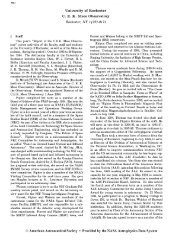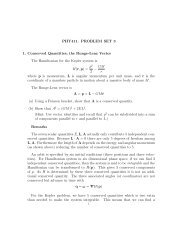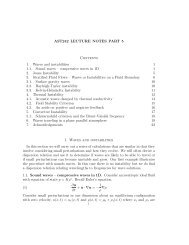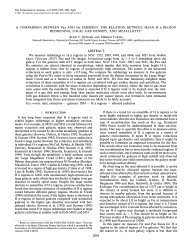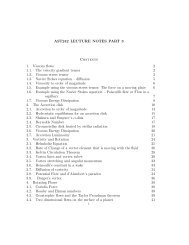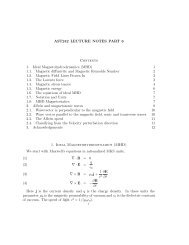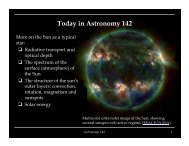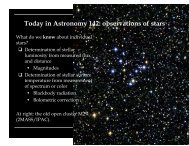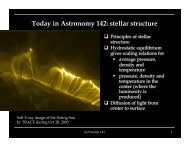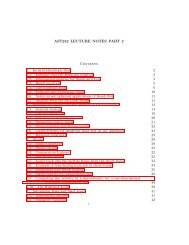Today in Astronomy 142: the Milky Way - Astro Pas Rochester
Today in Astronomy 142: the Milky Way - Astro Pas Rochester
Today in Astronomy 142: the Milky Way - Astro Pas Rochester
- No tags were found...
You also want an ePaper? Increase the reach of your titles
YUMPU automatically turns print PDFs into web optimized ePapers that Google loves.
<strong>Today</strong> <strong>in</strong> <strong><strong>Astro</strong>nomy</strong> <strong>142</strong>: <strong>the</strong> <strong>Milky</strong> <strong>Way</strong>The shape of <strong>the</strong> GalaxyStellar populations and motions! Scale height, velocities and <strong>the</strong>mass per area of <strong>the</strong> disk! Rotation curve, spiral armsBelow, <strong>the</strong> 13CO(1-0) 5kpcmolecular r<strong>in</strong>g survey:Boston University-FCRAO <strong>Milky</strong> <strong>Way</strong>Galactic R<strong>in</strong>g Survey(GRS).<strong><strong>Astro</strong>nomy</strong> <strong>142</strong> 1
Shapley and <strong>the</strong> location of <strong>the</strong> Galactic centerIn 1917, Harlow Shapley applied Henrietta Leavitt ‘spulsat<strong>in</strong>g-star distance-measurement discovery to <strong>the</strong>distribution of globular clusters. He reasoned that <strong>the</strong>seclusters were so massive that <strong>the</strong>y would accurately trace <strong>the</strong>Galaxy’s global gravitational potential.He found that <strong>the</strong>se clusters were arranged sphericallysymmetrically about a po<strong>in</strong>t <strong>in</strong> <strong>the</strong> plane of <strong>the</strong> <strong>Milky</strong> <strong>Way</strong>, <strong>in</strong><strong>the</strong> constellation Sagittarius, tens of kpc away.! Modern measurements give 8.5 kpc for <strong>the</strong> distance.Thus <strong>the</strong> Sun is quite far from <strong>the</strong> center of <strong>the</strong> Galaxy<strong><strong>Astro</strong>nomy</strong> <strong>142</strong> 2
The <strong>Milky</strong> <strong>Way</strong>’scentral regions, <strong>in</strong>starlight (near<strong>in</strong>frared),from <strong>the</strong>NASA COBEDIRBEexperiment.NGC 891, also <strong>in</strong>starlight (near<strong>in</strong>frared),from <strong>the</strong>2MASS survey (U.Mass./NASA).<strong><strong>Astro</strong>nomy</strong> <strong>142</strong> 3
Galactic founta<strong>in</strong><strong><strong>Astro</strong>nomy</strong> <strong>142</strong> 4
HI observations of <strong>the</strong> LMCKim et al. ACTA imagesshow<strong>in</strong>g HI shells and super shells<strong><strong>Astro</strong>nomy</strong> <strong>142</strong> 5
More edge-on galaxiesNGC 4303, credit Chris Howk and HST heritage team<strong><strong>Astro</strong>nomy</strong> <strong>142</strong> 6
More edge-on galaxiesNGC 4217 (HST image,Chris Howk)WIYN Consortium<strong><strong>Astro</strong>nomy</strong> <strong>142</strong> 7
Spitzer/IRAC and HST composite of <strong>the</strong>Sombrero Galaxy<strong><strong>Astro</strong>nomy</strong> <strong>142</strong> 8
Schematic structure of <strong>the</strong> <strong>Milky</strong> <strong>Way</strong>Figure: Chaisson and McMillan, <strong><strong>Astro</strong>nomy</strong> <strong>Today</strong><strong><strong>Astro</strong>nomy</strong> <strong>142</strong> 9
What was miss<strong>in</strong>g from that last slide?• The <strong>Milky</strong> <strong>Way</strong> is a barred galaxy• Molecular r<strong>in</strong>g outside <strong>the</strong> bar• The <strong>Milky</strong> <strong>Way</strong> is right now destroy<strong>in</strong>g a nearby diffusegalaxy called Sag A dwarf• In <strong>the</strong> halo <strong>the</strong>re are stellar streams which are remnants oftidally disrupted dwarf galaxies• The outer part of <strong>the</strong> galaxy is probably flocculent ra<strong>the</strong>rthan grand design• The outer part of <strong>the</strong> galaxy is warped and r<strong>in</strong>ged?• The disk has two components (abundances and star counts):th<strong>in</strong> disk (few hundred pc) and athick disk (1kpc),The thick disk is older.<strong><strong>Astro</strong>nomy</strong> <strong>142</strong> 10
Motions of stars <strong>in</strong> <strong>the</strong> Galaxy, and <strong>the</strong>ir use <strong>in</strong>determ<strong>in</strong><strong>in</strong>g its mass distributionHow much does <strong>the</strong> Galaxy weigh?Stars move about <strong>in</strong> response to <strong>the</strong> gravitational potential of<strong>the</strong> rest of <strong>the</strong> stars <strong>in</strong> <strong>the</strong> galaxy.Their systematic motions (rotation) can be used simply withNewton’s Laws to measure masses.! This works even better with <strong>in</strong>terstellar gas than withstars.Stars collide <strong>in</strong>-elastically very rarely, so <strong>the</strong>ir randommotions can be used with <strong>the</strong>rmodynamics to measuremasses - <strong>the</strong> stars <strong>in</strong> this sense can be thought of as particles<strong>in</strong> a gas.Let’s do some examples of <strong>the</strong> latter.<strong><strong>Astro</strong>nomy</strong> <strong>142</strong> 11
Mass per unit area of <strong>the</strong> Galaxy’s disk, <strong>in</strong> <strong>the</strong>Sun’s neighborhoodRecall formula for pressure <strong>in</strong> terms of particle numberdensity, speed and momentum (lecture, 9 February):Number of particles that hitwallTypical momentum per particleTime <strong>in</strong>terval <strong>in</strong> which <strong>the</strong>y hitConsider a certa<strong>in</strong> class of stars to be gas particles, andconsider <strong>the</strong> component of <strong>the</strong>ir motion perpendicular to <strong>the</strong>Galactic plane.Suppose <strong>the</strong> distribution of <strong>the</strong>se stars extends above andbelow <strong>the</strong> plane by some scale height H/2. Consider starsly<strong>in</strong>g on <strong>the</strong> ends of a cyl<strong>in</strong>der of Galactic matter that extendsabove and below <strong>the</strong> plane.<strong><strong>Astro</strong>nomy</strong> <strong>142</strong> 12
Mass per unit area of <strong>the</strong> Galaxy’s disk, <strong>in</strong> <strong>the</strong>Sun’s neighborhood (cont<strong>in</strong>ued)Weight of <strong>the</strong> cyl<strong>in</strong>der, approximately:dAIf stellar “gas pressure” balances gravity,<strong>the</strong>ndWH/2Compare to force on test mass m from<strong>in</strong>f<strong>in</strong>ite plane with mass per unit area µ(presumably done <strong>in</strong> PHY 121 or 122):Force from gravity:dW(All on RHS observable.)<strong><strong>Astro</strong>nomy</strong> <strong>142</strong> 13
Proof of <strong>the</strong> previous assertionmdFhrdrµ mass per unit area <strong><strong>Astro</strong>nomy</strong> <strong>142</strong> 14
An easier way to estimate <strong>the</strong> force from gravityfrom a th<strong>in</strong> sheet us<strong>in</strong>g Gaus’s lawA<strong><strong>Astro</strong>nomy</strong> <strong>142</strong> 15
Mass per unit area of <strong>the</strong> Galaxy’s disk, <strong>in</strong> <strong>the</strong>Sun’s neighborhood (concluded)Putt<strong>in</strong>g <strong>the</strong> numbers <strong>in</strong>, for <strong>the</strong> solar neighborhood:Star counts <strong>in</strong> <strong>the</strong> solar neighborhood enable us to estimate<strong>the</strong> lum<strong>in</strong>osity per unit area L (also called <strong>the</strong> surfacebrightness) of <strong>the</strong> disk locally. This leads to <strong>the</strong> mass to lightratio:Thus <strong>the</strong> solar neighborhood on average emits light lessefficiently than <strong>the</strong> Sun does – consistent with <strong>the</strong>re be<strong>in</strong>gmore lower-mass stars than higher-mass stars.<strong><strong>Astro</strong>nomy</strong> <strong>142</strong> 16
Dark matter I: <strong>the</strong> Galactic disk <strong>in</strong> <strong>the</strong> solarneighborhoodWhen this procedure was first applied to observations by Oort<strong>in</strong> <strong>the</strong> late 1940s, <strong>the</strong> result<strong>in</strong>g value of µ was greater than thatof visible stars and <strong>in</strong>terstellar gas <strong>in</strong> <strong>the</strong> Solar neighborhood bya factor of about 2.! Miss<strong>in</strong>g mass, or dark matter: mass that emits no light butcan be detected by its gravity?S<strong>in</strong>ce <strong>the</strong>n,! Better (less biased) samples of stars have led to smallerestimates of <strong>the</strong> total µ.! The discovery of neutral atomic and molecular gas <strong>in</strong> <strong>the</strong>ISM has <strong>in</strong>creased <strong>the</strong> “lum<strong>in</strong>ous” mass a bit.! Better count<strong>in</strong>g of <strong>the</strong> numbers of brown and white dwarfs! Now <strong>the</strong> lum<strong>in</strong>ous and gravitat<strong>in</strong>g µ nearly match.<strong><strong>Astro</strong>nomy</strong> <strong>142</strong> 17
Relation between dynamics and stellar population<strong><strong>Astro</strong>nomy</strong> <strong>142</strong> 18
Dark matter II<strong><strong>Astro</strong>nomy</strong> <strong>142</strong> 19
Add<strong>in</strong>g up <strong>the</strong> components<strong><strong>Astro</strong>nomy</strong> <strong>142</strong> 20
Spiral structure<strong><strong>Astro</strong>nomy</strong> <strong>142</strong> 21
The w<strong>in</strong>d<strong>in</strong>g problem for transient structure<strong><strong>Astro</strong>nomy</strong> <strong>142</strong> 22
Density wave <strong>the</strong>ory for spiral structure<strong><strong>Astro</strong>nomy</strong> <strong>142</strong> 23
Spiral densitywaves,HI, CO clustersand higherstellar densityall lie along <strong>the</strong>spiral arms<strong><strong>Astro</strong>nomy</strong> <strong>142</strong> 24
Spiral structure<strong><strong>Astro</strong>nomy</strong> <strong>142</strong> 25
Views of Spiral structure<strong><strong>Astro</strong>nomy</strong> <strong>142</strong> 26
X-shaped bulge<strong><strong>Astro</strong>nomy</strong> <strong>142</strong> 27
SummaryThe <strong>Milky</strong> <strong>Way</strong> as an edge on GalaxyGalactic founta<strong>in</strong>Spiral density wavesComponents of <strong>the</strong> <strong>Milky</strong> <strong>Way</strong>The <strong>Milky</strong> <strong>Way</strong>’s rotation curveHow to compute <strong>the</strong> vertical force from gravity from a th<strong>in</strong>sheet<strong><strong>Astro</strong>nomy</strong> <strong>142</strong> 28




